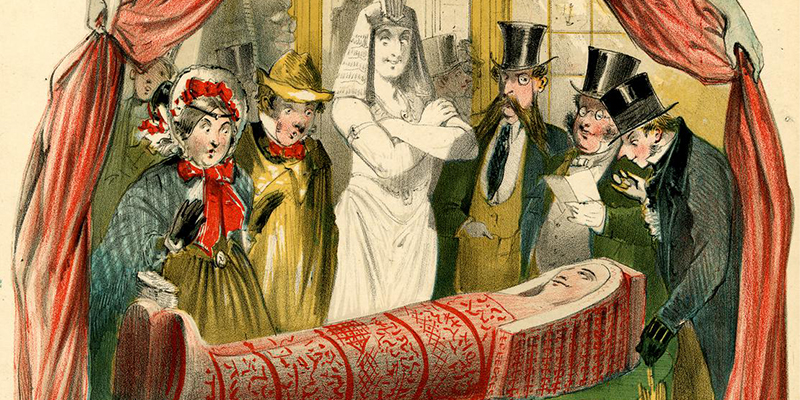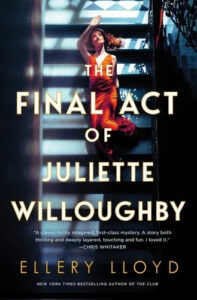In our new mystery The Final Act of Juliette Willoughby, the vastly wealthy aristocrat father of runaway heiress and artist Juliette is obsessed with all things Egyptian, and this obsession influences her own paintings. This is inspired by real events—the symbolism of Ancient Egypt fascinated the surrealist circle of the 1920s and 1930s (of which our fictional Juliette is part), appearing in the work of Salvador Dali, Max Ernst, and Leonor Fini, among others. In fact, Fini’s work, Little Hermit Sphinx, in London’s Tate Modern, inspired the fictional painting in which Juliette inserts hidden references to her family’s terrible secrets.
The symbols of Ancient Egypt also inspired some elements in our descriptions of the grand country house where Juliette was born—something we also borrowed from real life. The influence of Egyptomania—the fashion for all things Egyptian that swept across Victorian Britain, accelerating with the decipherment of the Rosetta Stone in 1822, which finally meant that hieroglyphics could be translated, and reaching fever pitch with the discovery of Tutankhamun’s tomb in 1922—can be seen in some of Britain’s grandest houses.
Of course, the wealth and the power by which British collectors were able to accumulate Egyptian artefacts in such quantities was very much a product of Britain’s global power, and this is a history both entangled and enabled by the history of Empire (Egypt was first an informal and then a formal British protectorate between 1882 and 1922). It is easy to understand why so many in Egypt and around the world feel that treasures in national collections in the UK, such as the Rosetta Stone, ought to be repatriated, as well as those that still remain in private hands. This is something that wasn’t acknowledged in the 1930s, when The Final Act of Juliette Willoughby begins—but, we explore in the novel, has rightly become a central issue in contemporary discussions.
Biddulph Grange
Egyptomania was not confined to the great indoors. The Egyptian section in these famous Victorian gardens in North Staffordshire, UK, was created from 1859 to 1862 and draws heavily on the fashions of the time. Owned by wealthy landowner and keen botanist James Bateman, who collected plants from all over the world, the garden features an Egyptian court, complete with a pair of sphinxes guarding the entrance of a tomb-style structure with a fairly terrifying statue of a baboon inside and a huge topiary pyramid behind.
Cairness House
This 16-acre house in Aberdeenshire, Scotland, recently sold for a very reasonable £1.25 million (sadly, not to us). Considered one of the finest examples of Neoclassical architecture in Britain, it was built over a decade at the end of the eighteenth century, with the great Sir John Soane responsible for its final aspect. The standout feature of this ten-bedroom house is the tomb-shaped Egyptian Room (designed in 1793), one of the earliest surviving of its type in the world. It is decorated in a complex mix of hieroglyphics, numerological, Masonic, and Pagan symbols that are said to form a secret (as yet undeciphered) encrypted message.
Kingston Lacey
This stately home houses the largest private collection of Egyptian artefacts in the UK, amassed by John William Bankes (1786-1855). Cambridge graduate Bankes, an unexpected heir to the vast Kingston Lacy estate, was a passionate explorer and meticulous recorder. During his travels in Egypt from 1815 to 1819, he amassed a detailed collection of notes and drawings of ancient monuments, which became a hugely important record as many became damaged or were lost. There are over 100 objects still on display in the house’s Billiards Room, including amulets, scarabs, bronzes, shabti (statues placed in Egyptian tombs) and papyri. There is a huge marble obelisk in the gardens and, most fascinatingly to us (and something we have echoed in our book), in 2007 an unmarked crate in the basement was discovered packed with fragments of pottery and papyri.
Didlington Hall
This now-demolished 80-bedroom grand estate in Norfolk was owned by William Amhurst Tyssen-Amherst, who amassed a collection of ancient Egyptian art so large that he built a 2,500 sqft museum for it, guarded by seven statues of the lion-headed goddess Sekhmet. Visitors included the Prince of Wales and novelist H. Rider Haggard, and most interestingly, animal painter Samuel John Carter and his young son, Howard, who was completely captivated by the collection. That little boy was, of course, Howard Carter, who would go on to discover Tutankhamun’s tomb.
Highclere Castle
Famous now for being the filming location for Downton Abbey, Highclere has a significant Egyptian collection. George Herbert, the fifth Earl of Carnarvon, financed and participated in the discovery of Tutankhamun’s tomb with Howard Carter, which led to an unparalleled collection of Egyptian artefacts, including statues, jewelry and mummies, golden funerary masks, canopic jars, and pottery. After the Earl’s untimely death in Cairo—rumoured to be caused by the dreaded Tutankhamun’s curse—the collection became a point of intrigue and fascination.
***


















